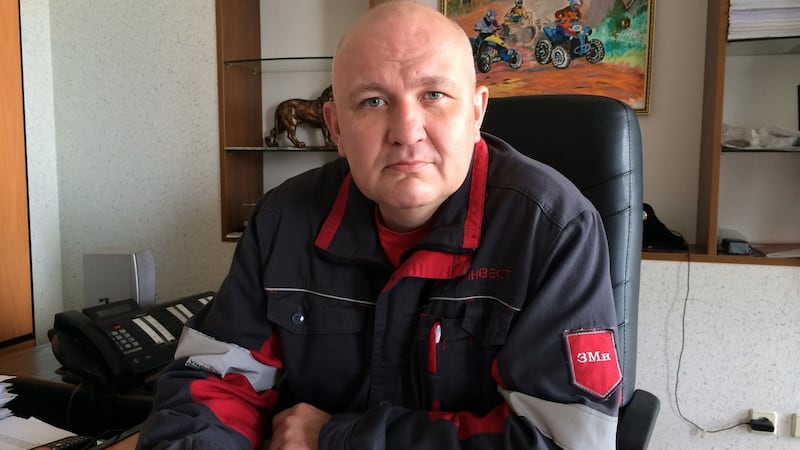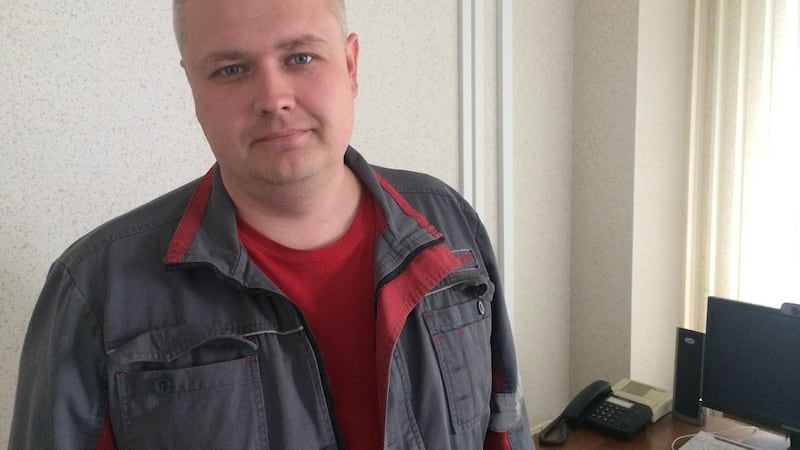Ruslan Kolisov has brightened up his office with pictures of quad bikes racing through the dirt, and he credits the hobby for his expertise in navigating the trails and back roads that criss-cross eastern Ukraine.
A closer look at Kolisov's corner of the vast Avdiivka Coke Plant yields other glimpses of his life in this war-scarred town: the middle of one of the pictures is torn; a chunk of wood has been gouged from the cabinet beneath it and a hole at head height has been punched through the door to the adjacent office.
“The shrapnel flew in when mortars landed there, where you see those two craters that have been patched up,” Kolisov says as he looks out over a factory yard.
“Donetsk airport was over there,” he adds, lifting his gaze to the middle distance. “You could see the control tower until it was blown up.”

The ruins of the airport are about 10km away, on the other side of a front line that is only half that distance from here as a shell flies.
The factory and its grounds have been hit more than 320 times by rockets, shells and mortars during fighting between Ukrainian troops and Russian-backed separatists that has taken about 10,000 lives and displaced 1.5 million people.
Two employees have been killed at the plant, 10 others have died in shelling of Avdiivka’s residential areas and dozens have been injured. On May 13th two factory workers were among four people killed when artillery fire struck the yard of a nearby house, orphaning two young girls.
Yet 4,000 or so people still work here, keeping the fires burning at a plant that was central to a Soviet-built industrial network that withstood nearly three years of war, until a recent, sudden deepening of divisions tore it apart.
Warlord seizures
On March 1st separatist warlords seized all Ukrainian-owned businesses operating on territory they control, after Ukrainian activists blocked cargo at the front line to halt what they called a “trade in blood” between Kiev and the militants.
These moves not only severed the sooty arteries that carried the region's economic lifeblood, they also accelerated the rebel regions' unofficial integration with Russia and Kiev's bid to break the pervasive influence of Moscow: in recent weeks, Ukraine has cut power to some militia-held areas and taken measures to sideline Russian firms involved in everything from banking to social media.
The expropriations cut the Avdiivka plant's ties with mines that provided it with coal and steelmakers that bought its coke, most of which were part of the empire of Ukraine's richest "oligarch", Rinat Akhmetov.
For Kolisov and colleagues, these are the latest of countless wrenching changes that were unimaginable before 2014, when Russia reacted to Ukraine's pro-western revolution by seizing Crimea and fomenting war in the east.
I could go to another region and find work, but I want to be here until peace returns
As the factory’s transport chief, Kolisov has found himself leading repair brigades to fix power lines amid artillery fire, and crossing the front line to scout safe routes for buses taking workers to and from the plant.
“People here know that if the factory closes, Avdiivka will become a village. We provide almost all local jobs and heating for the town in winter,” he says.
“I really want our town to survive. I could go to another region and find work, but I want to be here until peace returns. I want to see these problems end and I want to see Avdiivka and the factory develop.”
Constant stress
Alexei Bobyr, the head of the plant's production department, is similarly resolute.
“It’s impossible to get used to the constant stress and the sense of waiting for something bad to happen. Those who can’t take it have gone,” he says of a town that has seen about one-third of its prewar population of 35,000 flee to safer areas.
“The two workers who were killed here were young people just doing their jobs. The shelling started and they couldn’t take cover in time. That feeling of helplessness is hard to handle,” Bobyr says.

“No one can force someone to work in these conditions. But if people don’t come here we will have to shut down, and coke-making is a constant process,” he adds, explaining that if the plant’s giant furnaces go cold they cannot be restarted.
“If we stop, we stop forever.”
Despite nightly shelling and nearby skirmishes and the recent cutting of key supply and delivery routes, the plant continues to function: it is now importing coal from South Africa and has ramped up production after the completion of a new power line from government-held territory.
For mines and factories on the other side of the front line, the future is murkier. Reports suggest many workers have been sacked or given unpaid leave as enterprises close or scale back production, and it is not clear how deeply Russia is willing to integrate or invest in the depressed militant-run areas.
"For our group the expropriations have been difficult but not catastrophic. But we have 'lost' 47,000 workers, and the impact on them will be very serious," says Jock Mendoza-Wilson, a spokesman for Akhmetov's conglomerate, System Capital Management (SCM).
Ukraine’s economic hit
Several hundred of those workers have now taken jobs with SCM in government-held regions, “and we expect more to come across the line as the reality of low income and poor prospects in separatist-controlled territory hits home,” he adds.
Russia supplies electricity to some militant-held areas and recognises passports and other documents they issue as legally valid
Ukraine expects lost tax and export revenue from the east to wipe at least one percentage point off already sluggish growth this year, as products from seized enterprises go to Russia and then points unknown.
Russia now supplies electricity to some militant-held areas and recognises passports and other documents they issue as legally valid, drawing the region closer while continuing to deny the Kremlin’s dominant military and political role there.
“Until all this is sorted out on a political level, no ceasefire will hold while the two sides are so close to each other,” says Bobyr, thinking of the nearby frontline where only a few hundred metres divide Ukrainian troops from separatist gunmen.
“After three years, I understand this won’t suddenly be fixed overnight,” he says. “But we are all waiting for a solution.”



















